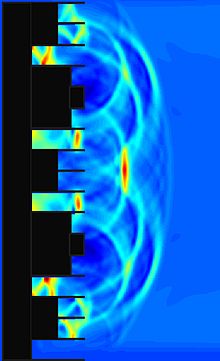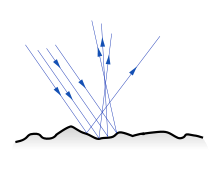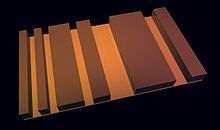Diffuser (acoustic)
In acoustics, a diffuser is a component that is intended to disperse incident sound waves and reduce the undesirable effect of the otherwise uniformly reflected sound. The sound waves are distributed more evenly in the room both quantitatively and qualitatively by diffusers. If the waves reflected several times in this way hit the ear later, the individual frequencies come from different directions in a disordered manner, which makes it difficult to localize the original sound source. This changes the spatial impression .
application areas
The main areas of application for diffusers is to improve room acoustics in auditoriums , concert halls and in control rooms and recording rooms in sound studios . They can also be found in technical measuring rooms for assessing the quality of loudspeakers and for assessed noise measurements on industrial devices. Recently, diffusers can also be found increasingly in HIFI listening rooms of private users.
By directing and frequency-dependent scattering of the sound waves, different areas can be created in these rooms, in which the sound emitted by a sound source is quantitatively maintained in a desired proportion without the formation of room modes . In addition, the effect of the reflection on walls is partially canceled out, which means that the size of the room and its properties are no longer so obtrusive or seem to disappear and the audibility is improved. Speech and other high-frequency sound components in particular can be perceived better.
This is used in recording studios to listen to the subjective size of a room, as it is shown in the audio signals of the stereo system , unaffected by the actual size of the studio. Typically, diffusers are located in the non-damped area of the listening room (see Live End Dead End ). Diffusers are in contrast to the absorbers , which are also used in studios , which are supposed to dampen the sound .
In large concert halls and opera houses, diffusion is also achieved by arranging the corresponding structural elements in a non-uniform manner and integrating them appropriately into the overall room concept. In addition to the staircase-shaped arrangement of the seating and grandstands, this also applies to the design of sound reflectors above the musicians in the orchestra area. To this end, modern theaters and concert halls are planned with the help of complex sound analyzes using simulation software.
function
The essential function of diffusers is that parts of the sound wave that arrive at different points are not reflected back according to the reflected angle of incidence, as would have been the case on a smooth wall, but are directed in different directions. This is achieved both by partially twisting parts of the cladding as well as by elevations and depressions in the material. Due to the resulting unevenness, 2 different effects are used, depending on the wavelength:
For sound components whose wavelength is significantly smaller than the size of the twisted sub-element, a direct reflection of the wave packet takes place using the law of reflection . The deflection takes place in accordance with the orientation of the partial area. The sound wave is, so to speak, fragmented.
The superimposition of the reflections due to different depressions in turn leads to interference effects : Waves of different frequencies are superimposed and, depending on their wavelength and the phase offset specified by the depression , partial extinctions and amplifications occur. If you consider the maxima and pressure gradients of the newly emerging wave, they are steered in different directions. This applies above all to the wave incident directly from the 90 ° direction, which would otherwise be thrown back directly.
Diffusion is therefore primarily suitable for medium and high frequencies, since unacceptable depths would be required for bass.
Designs
1D diffusers
One-dimensional diffusers have a uniform structure along one axis and work with both functional principles. As a rule, they are aligned against the axis of hearing, i. H. the depressions run vertically in plan view. This results in a strong distribution of the frequencies on the horizontal stereo basis .
Some designs make predominantly use of the interference. They are optimized for a specific frequency by adapting the relative depths to a specific wave period. The diffuser is then particularly effective for this frequency, which, however, means that individual frequencies can be perceived in the vicinity of the diffuser with a strong emphasis.
There are a number of ways of arriving at combinations of numbers that lead to a more or less statistical scattering behavior.
Quadratic Residue Diffusers (QRD)
A well-known design is the form of the "Schroeder diffuser" named after Manfred Schroeder . It is rectangular in shape and consists of individual chambers of different depths, separated by partition walls, which are adapted to a certain wavelength. The concept is based on the theory that the waves are best scattered if a repeating structure based on a sequence of numbers corresponding to fractions of the wavelength is used for the depth of the chambers. The number of the recess is squared in ascending order and the mathematical remainder, the so-called "residual", is formed, which results from division by a prime number. The course of the depths thus corresponds to that of a parabola with branches offset by full periods. Therefore diffusers of this type are also called QRD ( q uadratic r esidue d iffusor).
QR diffusers are naturally symmetrical around a dedicated point. A symmetrical stereo image can thus be maintained with just a single component in the middle of a room.
The structure can also be inverted, i.e. H. by swapping lows and highs, because then the wave periods also act accordingly.
Sometimes you can find QRD where the dividers have been left out. The effect is greatly weakened because the delayed reflected wave packets are no longer so concentrated. On the other hand, this can be advantageous if the distance to the diffuser is short, because less clear resonances arise that could interfere in the vicinity.
Cubic Residue Diffusers (CRD)
A similar method is to apply the cube function to the number of the element instead of the usual square. This cubic rule creates a more scattered radiation pattern. CRD diffusers are better suited for small spaces.
However, there is no longer any periodic mirror symmetry within the component, since the cube function is an odd function from a mathematical point of view . Since rooms usually require a symmetrical stereo image, an additional, mirror-symmetrical diffuser must be used.
However, this radiation behavior has not yet been adequately investigated and the design is hardly widespread in practice.
Maximum Length Sequence (MLS)
Geometries based on the Maximum Length Sequence method are also very well known . They also belong to the Schroeder diffusers. and use only a single value for the depressions, which however have different widths that follow the maximum sequence of zeros and ones as it results from the polynomial division . The width is less than or equal to half the wavelength of the frequency that is being optimized for. However, their effectiveness is limited compared to QRDs. A wall structure made of MLS appears narrower.
Primary Root Diffusers (PRD)
Another design are so-called primary root diffusers, which are based on sequences of simple roots . The behavior is similar to that of the QRD. The main difference is that the QRD deals with sound waves that only come from one geometric plane, while the PRD also deals with sound waves that come in in two planes, i.e. come from any point in space.
Alternating Binary Frequency Diffusers (ABF)
These are similar to the QRD diffusers and represent a combination of several superimposed binary sequences.
Micro-Perforated Diffusers (MPD)
MPDs consist of individual, strip-shaped arranged resonators which oscillate at different resonance frequencies. As a result of the resulting different wall impedances, incident waves are diffusely reflected. The resonance frequencies result from pseudostochastic number sequences.
2D diffusers
If sound waves are to be scattered in all spatial directions depending on the frequency, a 2-dimensional arrangement is recommended, in which two 1D diffusers are superimposed orthogonally. As a result, the incoming waves are scattered even more disorderly, which can be particularly advantageous in small studios and control rooms. In contrast to other diffusers, two-dimensional diffusers scatter the sound in a hemispherical pattern. This is done using a grid, the cavities of which have depressions of different shapes, corresponding to the matrix addition of two square sequences that correspond to those of a regular diffuser. These diffusers allow good control of the diffusion direction. Here, too, there are a number of diverse concepts with different shapes and design methods. Due to the design, which is reminiscent of skyscrapers, these are often referred to as skyline diffusers. The first unidirectional 2D diffuser was patented by RPG in 1990. The Skyline diffuser followed in 1995.
For practical reasons, the dividers are often left out in the 2-dimensional version, which results in a different radiation behavior that no longer corresponds to the Schroeder diffusers.
QRD / CRD diffusers
A simple way to generate symmetrical and periodic arrangements is also here the QRD method. This is based on the modulo function , but both coordinates play a role here and are included in the calculation in different ways. Depending on the calculation and the offset of the coordinates, there are different structures.
Statistical diffusers
Today empirically obtained and statistically distributed numbers are increasingly accepted in order to achieve as uniform a spread as possible. One possibility is to use feedback equations such as those used in the generation of CRC codes.
use
The numbers resulting from the calculation rules are mostly periodic along the axes, i.e. H. the structure repeats itself. Several of the resulting elements can be strung together. This increases the effect of the overlapping wave packets to form a new deflected wave. It is advisable to extend the diffusion over an entire wall and to use the walls as a mirror. Since diffusers have a defined direction of radiation, they can also be attached alternately.
However, this wave is only fully formed at a certain distance from the diffuser, which is greater the lower the design frequency of the diffuser and the wider the diffuser. Therefore, when placing the diffuser, ensure that there is sufficient distance to the listening position of the operator. Between about 20% of an area should be covered in order to achieve a significant effect.
In the HIFI area, the attachment of diffusers in the area behind the speakers has become established. However, the effect is controversial.
materials
Diffusers are made from different materials. There are lightweight versions made of foamed Styrofoam , as well as composite systems made of wood and even metal. The main material is wood because it does not have a pronounced tendency to vibrate, has a high level of self- damping, is easy to process and is still sound-hard enough. A sufficiently strong reflective effect - especially at lower frequencies - is the prerequisite for the functioning of the diffusion and can only be achieved with very reverberant material. Diffusers made of soft materials such as EPS / XPS are therefore partially hardened with epoxy resin in order to improve their effectiveness. Sound that is not reflected is absorbed by such elements and remains unaffected, see transmission .
Spatial scattering behavior
Simple calculation and viewing
The well-known analytical calculation methods published by Schroeder for acoustic diffusers show the relationship between the surface structure and the spatial distribution of the sound: The radiation characteristics of a surface in the acoustic far field can e.g. B. be calculated by Fourier transformation of the surface structure.
The calculation result can then be displayed as a directional diagram. It illustrates the frequency-dependent, spatial radiation behavior of the surface in one plane.
It should be noted that this applies to an ideal, perfectly radiating diffuser. In practice, diffraction and the finite size of the surfaces result in different effects.
Three-dimensional calculation and viewing
The complete calculation of the acoustic behavior of a diffuser is possible based on the superposition of acoustic monopoles according to the Huygens principle . This allows the three-dimensional sound pressure distribution to be calculated and visualized at different frequencies in all spatial directions.
In comparison to the one-dimensional construction, the spatially expanded scattering effect of two-dimensional diffusers becomes clear. It can be seen that a three-dimensionally balanced sound scattering can be achieved with a two-dimensional QRD.
Simulation of the sound field
The entire sound field that arises in a room processed with diffusers can now be planned with suitable software and calculated in advance and measured in detail, etc. a. with EASE and COMSOL.
Other uses
Microdiffuser
The method of diffusing sound waves by means of Schröder diffusers is also used on microscopically finely structured surfaces in order to create special high-frequency components.
Web links
- Walker, Eng (BBC): Design and Application of Acoustic Diffusion
- Dr. Jörg Hunecke: Functional principle of diffusers
- Bill "Collo" Collison: Free construction software QRDude
- Arqen Sonic: Free Blueprints for Diffusers
- Alexander Ulz: Acoustic diffusers
- Jürgen Schuhmacher: Different diffuser concepts
- David Browne: Using Acoustic Diffusion
- Fischer / Stens: Do-it-yourself acoustic measures
- Torben Bostelmann: Acoustic Diffuser - Effect & Function
- HX AUDIO LAB: Diffuser calculation and explanations
- Home cinema practice: functionality, calculation and DIY
- Dr. Benedikt Kohout on acoustics, studio magazine
- DEGA: waves and fields in acoustics
literature
- Manual of electroacoustics; Günther Boye, Urbi F. Herrmann; Hüthig Buch Verlag Heidelberg; ISBN 3-7785-1575-6 .
- EMPA / HSR conference 2001; "Wood in room acoustics"; Author: Kurt Eggenschwiler
- Acoustic Absorbers and Diffusers: Theory, Design and Application, Dr Trevor Cox, Dr Peter D'Antonio CRC Press, 2004, ISBN 0-415-29649-8 .
credentials
- ↑ Farshid Shahlawandian: The LowBeats HiFi listening room: you can hear everything here. Low Beats, November 2017, accessed July 9, 2020 .
- ↑ Klaus Burosch: The listening room at medium and high frequencies. Office, accessed on July 14, 2020 .
- ^ Alfred Schmitz, Anselm Goertz: Planning of rooms. (PDF) DEGA Academy Room Acoustics and Public Address, 2012, accessed in 2020 .
- ↑ BauNetz: Schroeder diffusers (principle) | Acoustics | Sound reflection | Baunetz_Wissen. Retrieved July 9, 2020 .
- ↑ Juergen Schuhmacher: Cubic Residue Diffusers. 96khz, April 20, 2015, accessed April 20, 2015 .
- ↑ Jörg Bohne: Rules and Tips. In: bohne-audio.com. October 12, 2017. Retrieved October 12, 2017 .
- ↑ Dr. Jörg Huneke: Diffusers. Retrieved July 9, 2020 .
- ↑ Andreas Melcher: Sound scattering with phase gratings. AM Acoustic, 2020, accessed July 14, 2020 .
- ↑ Alexander Ulz: Acoustic diffusers. (PDF) TU Graz, accessed in 2020 .
- ^ Desiderata: The PRD panel. In: http://desiderata.xyz/ . June 13, 2016, Retrieved July 10, 2020 (American English).
- ↑ 96kHz: Alternating Binary Frequency Diffusers. In: www.96khz.org. 2007, accessed on July 14, 2020 .
- ↑ Jörg Hunecke: Micro-perforated diffusers (MPD). In: hunecke.de. Retrieved July 14, 2020 .
- ↑ Hans Werner Strube: More on the diffraction theory of Schroeder diffusors , J. Acoust. Soc. At the. 70, 633 (1981), doi: 10.1121 / 1.386757
- ↑ Nils Hitschke: diffusers: Functionality, calculation and DIY. In: Heimkino Praxis. February 11, 2018, accessed July 9, 2020 .
- ↑ Omnifusor. (PDF) In: http://www.rpgacoustic.com/ . RPG, 1990, accessed in 2020 .
- ↑ Felix Baarß: FAQ acoustic elements: diffuser, absorber, bass trap - delamar. In: www.delamar.de. July 13, 2015, accessed July 13, 2015 .
- ↑ Schuhmacher Jürgen: Quadratic residue diffusers. 96khz, 2003, accessed in 2020 .
- ↑ Jeff Hedback: Diffusion A Wonderful Tool. GIK, June 1, 2009, accessed July 14, 2020 .
- ↑ Stefan Gawlick: TechTalk - diffuser + resonator. FIDELITY online, September 14, 2014, accessed on July 14, 2020 .
- ↑ Diffuser for speakers near the wall, acoustics - HIFI-FORUM. Retrieved July 23, 2020 .
- ↑ Schroeder, Manfred R. "Binaural dissimilarity and optimum ceilings for concert halls: More lateral sound diffusion." The Journal of the Acoustical Society of America 65.4 (1979): 958-963.
- ↑ Schroeder, Manfred R. "Diffuse sound reflection by maximum length sequences." The Journal of the Acoustical Society of America 57.1 (1975): 149-150.
- ↑ OTH Amberg-Weiden: EASE - Samurai. Ostbayerische Technische Hochschule Amberg-Weiden, 2018, accessed on July 31, 2020 .
- ↑ Jörn Hübelt: Measurement and simulation of sound fields . In: hs-mittweida.de. 2020, accessed on July 31, 2020 .
- ↑ Yifan Zhu, Xudong Fan, Bin Liang, Jianchun Cheng, Yun Jing: Ultrathin Acoustic Metasurface-Based Schroeder Diffuser . In: Physical Review X . tape 7 , no. 2 , June 5, 2017, p. 021034 , doi : 10.1103 / PhysRevX.7.021034 ( aps.org [accessed July 31, 2020]).
















